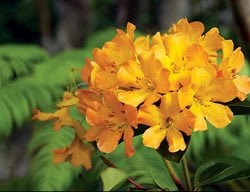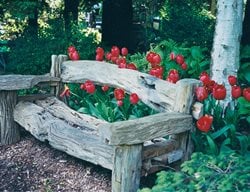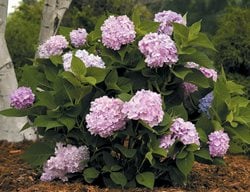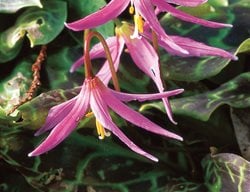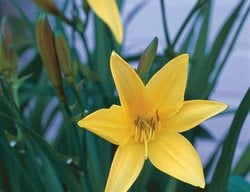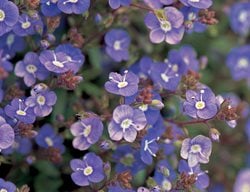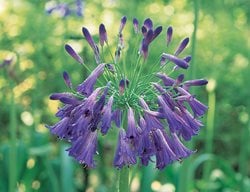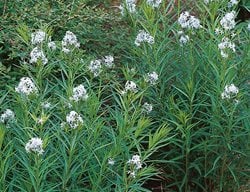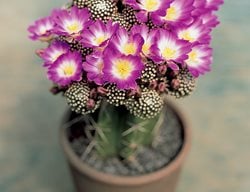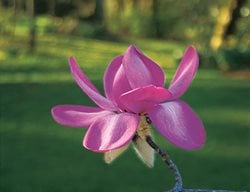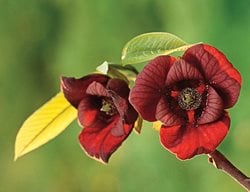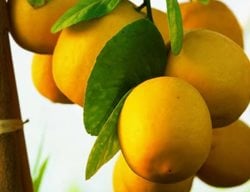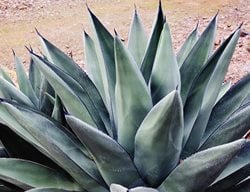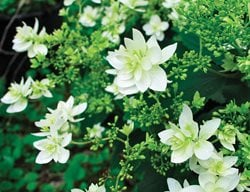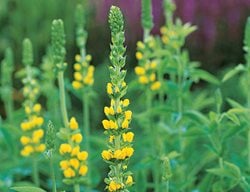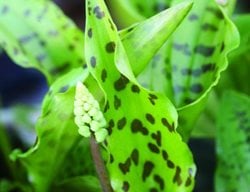I Love This Plant

VIREYA RHODODENDRONS
When I return to my hideaway on Hawaii’s Big Island and begin the familiar ascent up my curvaceous, garden-bordered driveway, I’m looking for the vivid splashes of delicious color that are Vireya rhododendrons. Ranging in hues that include rich buttery apricots, bright oranges, pure yellows, clear raspberries and just about every color in between, the Vireyas are the crown jewels of my Hawaii garden.
The good news is that they also flourish in my Fairfax, California, garden. Here, I utilize them in pots, moving them from a growing area (they like bright conditions but need protection from the midday sun, similar to cymbidium orchids) into more-prominent garden locations when in bloom (I move mine to the pool area so I can see them through the glass French doors). Plus, container cultivation makes it easy to protect these beauties from a winter frost by moving them under a dense tree canopy, against a sunny south wall or even indoors if the need arises.
Because many Vireya species grow as epiphytes in their natural environment, they are excellent candidates for pot culture, and the more-pendulous varieties can be grown in hanging baskets. The more than 300 Vireya species originate in the cooler mountainous regions of Southeast Asia, but they have been extensively hybridized over the past 30 years, yielding a dazzling selection of named varieties. Vireya plants range in size from miniature (12 to 24 inches) to tall shrubs (up to 8 to 10 feet). Flower size varies from clusters of candy-corn-size bells to trusses of huge trumpets. Many are fragrant, and most bloom off and on throughout the year.
—Davis Dalbok

‘BING CROSBY’ TULIP
When he planted 50 tulip bulbs last fall at the Harvest Inn in St. Helena, California, did Napa Valley garden designer Daniel Townsend have any idea how great they would look one day in May as the flowers intertwined and created a backdrop for a weathered garden love seat? Of course, he says. The tulips are ‘Bing Crosby’, an 18-inch-tall, early-blooming, brilliant scarlet classic Triumph tulip. The love seat, made of molave wood (harvested from fallen trees), was imported from Indonesia by a local furniture dealer. Harvest Inn, in the heart of the Napa Valley wine country, has 8 acres of gardens. For accommodations or garden visiting, see www.harvestinn.com.
—Bill Marken

ENDLESS SUMMER HYDRANGEA
I felt like saying, “come on, it’s over, sorry, move on,” as Endless Summer™ hydrangea continued to bloom profusely at Halloween and hung on gamely beyond Thanksgiving in its first year in a pot in my garden. A long, warm northern California autumn had a lot to do with the extended flowering season. But give more credit to the plant’s genes.
This new variety of good old Hydrangea macrophylla, scheduled for wide distribution this spring, is considered to be repeat-blooming. Its secret is that flower buds are formed on new wood that appears during the growing season—rather than the way hydrangeas typically form flower buds on stems that grew the season before. This means that flowers continue to develop as new green growth does. It also means that frost damage or your bad pruning timing won’t wipe out a season’s worth of flowers.
Endless Summer™ also is hardier than most hydrangeas. Originally discovered 20-some years ago—blooming in September! —at Bailey’s Nursery in St. Paul, Minnesota, it is hardy to Zone 4.
The shrub grows about 3 to 5 feet tall. The flowers are large, up to 8 inches across. They are a bright blue in acid soil, pink in alkaline soil. If you have alkaline conditions and want blue, follow the standard hydrangea advice: Apply aluminum sulfate to the soil ahead of the bloom season. Cut off flowers as they fade to encourage continued blooming. Available at many retail garden centers through Monrovia, www.monrovia.com.
—Bill Marken

FAWN LILY
As a student, one spring field trip took me to a woodland garden where I saw for the first time the fawn lily, Erythronium revolutum. The simplicity of its form etched itself in my memory—two basal leaves arch up and out like small, exotic marbled-leaved hostas, and the elegant 6- to 12-inch stem rising from their center is crowned by two or three reflexed, pink, lilylike flowers. I bought two bulbs that day, and Eric and Ernie, as they became known, took pride of place on a cool windowsill. Upon graduation I became head gardener at The Garden House in Devon, the cool, damp, southwest corner of England. My first spring in the job I was ecstatic to find the ground literally heaving as thousands of Erics and Ernies pushed through the soil.
The coast fawn lily, a native of the western U.S. and Canada (Zones 5 to 8), varies tremendously in flower, leaf and flowering period, and the process of looking into their flowers became a spring ritual for me. Out of this came some beautiful hybrids such as ‘Rosalind’, ‘Janice’, ‘Apple Blossom’ and ‘Winifred Lorraine’, but if you hanker for drifts of pink, plant E. revolutum itself. Fawn lilies are not the easiest plants to grow, but, in the right location (the sort of cool, moist spot favored by primroses), it will self-seed.
—KEITH WILEY, author of On The Wildside (Timber Press).

DUMORTIER’S DAYLILY
My first spring in my Nashville house was a season of surprises. The house was built in 1940 and had had relatively few owners during its 50-plus years. What little garden there was contained old-fashioned plants—iris, Easter lily, snowball viburnum, crape myrtle, perennial sweet pea, tiger lily, daylily and black-eyed Susan. The previous owner, a “little old lady,” loved her plants and was forever digging holes in the bermuda grass and moving things around the yard. Among the run-of-the-mill orange daylilies and yellow bearded irises were a few treasures. One of them was Dumortier’s daylily (Hemerocallis dumortieri), an extremely early-blooming, fragrant, species daylily.
Working at a botanical garden with a daylily collection, I was familiar with the latest, largest, frilliest, most colorful hemerocallis hybrids. But this was so old, it was new again—at least for me. Though recognizing the plant as a daylily, I was startled to see it blooming in April, well ahead of its fancier relatives, with a sweet, lemony fragrance. Dumortier’s daylily is short and compact, about 1 1/2 feet tall and wide, with narrow foliage.
The smallish flowers, standing just above the leaves, are golden-yellow, with a distinguishing reddish streak on the backs of the tepals. I valued this little plant as much as any I had paid money for—more, actually, because it made me think of wild daylilies growing in exotic oriental lands and of an old lady who loved her garden. It was so special, in fact, that it moved with me to my next house.
Occasionally offered through specialty nurseries, such as Niche Gardens in North Carolina (see www.nichegardens.com or call 919-967-0078 for more information).
—Jenny Andrews

CREEPING SPEEDWELL
One of my first college classes was botany, and we spent a good deal of time examining the weeds growing in the campus lawn. To this day I have a fondness for some of these plants, despite my efforts to remove them from the garden. Among these beloved weeds is bird’s eye speedwell, with its tiny blue flowers and catchy name. For years I wished there could be a plant with the beauty of the blooms without the weediness of the plant. Then came Veronica peduncularis ‘Georgia Blue’.
Beginning as early as March in Zone 6, creeping speedwell produces a cloud of small, four-petaled, electric-blue flowers that sparkle in the spring sunshine, a perfect match for grape hyacinths and an ideal foil for yellow daffodils. Full bloom can continue for two months or longer, with a few sporadic flowers appearing through the season. The low mat of small, dark-green leaves and wiry stems, 6 to 10 inches high, creates a netting that is easy for other plants, especially bulbs, to grow up through. Perennial in Zones 5 to 8, the foliage takes on a dark-purplish cast in cool weather, providing a bit of winter interest. Discovered by Roy Lancaster of England, it was named for the Republic of Georgia in Asia (not the U.S. state so don’t say its name with an exaggerated Georgian accent as I used to do before I knew better).
The name speedwell comes from an old meaning of the word speed: “to thrive.” Though the reference is to other species of veronicas purported to have medicinal properties, it also applies to the ease of care of ‘Georgia Blue’. A little afternoon shade, average garden soil and a bit of water during dry spells are all it requires. Almost as easy to grow as a weed!
Most veronicas have spikes of tiny flowers. Creeping speedwell forms a low ground cover, with masses of brilliant blue, pea-size flowers in the spring.
—JENNY ANDREWS

AGAPANTHUS
Lily-of-the-Nile (Agapanthus africanus) hails from the banks of Egypt’s Nile River, and has become the hardy workhorse of city landscaping in many southern parts of the United States. In California, agapanthus seems to decorate every business park entrance—it borders the freeways and festoons grocery-store parking lots.
Yet despite its ubiquity, set against the backdrop of a wild, overgrown garden or a kempt, well-manicured lawn, agapanthus can take its rightful place as a compelling addition to any landscape. Those who are still children at heart will appreciate the peculiar, Dr. Seuss charms of its globe-shaped blooms.
Jumping up in jack-in-the-box fashion from a sprawl of strap-shaped leaves, the flowers range in color from dark violet (‘Elaine’) to snowy white (‘Albus’). Comprised of umbels sporting petite star-shaped flowers, their heads totter at the ends of sturdy stems, some of which can grow up to 6 feet tall.
Agreeable, prolific and pretty, these tender evergreen or deciduous plants prosper in Zones 7 to 11, where they bloom from late spring to early autumn. In colder climates they can be grown as warm-weather annuals and are perfect container plants. Whether planted close together in colorful vignettes, in long tailored rows or containers, agapanthus will beautifully punctuate an exterior space. Long-lasting as cut flowers, the blooms, with their stylish, geometric form, give a unique accent to compact bouquets as well as enhance tall, architectural arrangements.
—VERONICA D’ORAZIO

ARKANSAS BLUE STAR
Leslie Hubricht was a renowned 20th-century naturalist and an expert on North American freshwater mollusks. While on a 1942 collecting trip to west-central Arkansas, he took cuttings from an unusual flowering plant and passed them on to the Missouri Botanical Garden in St. Louis. A year later, botanists there identified Hubricht’s find as a distinct species of the genus Amsonia. It was christened Amsonia hubrichtii, also known as Arkansas blue star.
Growing about 3 feet tall, Arkansas blue star’s erect stalks arch slightly outward. A mature plant can spread to 4 feet in diameter. In spring flat-topped clusters of pale-blue, five-petaled flowers appear at the tops of the stalks. The plant’s common name comes from the slender flower petals that give each blossom a starlike appearance. Matchstick thin, 3-inch-long leaves sprout along the entire length of each stem in bottlebrush fashion.The foliage is dark green and lacy or grasslike for most of the growing season. In October the foliage comes into its own and turns golden yellow. Seen from even a short distance, a group of Amsonia hubrichtii plants resembles a glorious golden cloud.
Like its better-known cousin, Amsonia tabernaemontana, Arkansas blue star thrives in USDA Zones 5 to 9, in full sun and ordinary, well-drained soil. Once established, it is reasonably drought-tolerant. Like milkweed and other members of the family Apocynaceae, Amsonia hubrichtii has a milky sap that is irritating to deer and other garden pests. Any plant that can be both attractive to humans and repellant to deer is a good choice for vulnerable gardens.
—ELIZABETH GINSBERG
You can find Amsonia hubrichtii at Digging Dog Nursery, Albion, CA; 707-937-1130; www.diggingdog.com or at Wayside Gardens, Hodges, South Carolina; 800-845-1124; www.waysidegardens.com

MAMMILLARIA LUETHYI
Sometimes we don’t love or even like a plant at first, but our feelings change as we learn about it or as it struts its stuff. I acquired this specimen a few years ago from a friend who had second thoughts about it.
I was happy to add the speckled lump on a spiny stick to my collection, but it didn’t immediately displace anything from my Top 10 list. A few visits to cactus-related Web sites made me realize I had something very choice, and when Lumpstick dramatically took center stage this spring, I was in love.
RELATED: Succulents
Mammillaria luethyi could serve as a poster plant for conservation, since it is known to grow naturally in only two small areas of the Mexican state of Coahuila, where it clings to limestone outcrops. For several years those locales were the closely guarded secret of two intrepid plant explorers who rediscovered this species in 1996.
This treasure adapts well to cultivation if grafted onto a more vigorous relative. For a few days in spring the dense crown is nearly obscured by vivid magenta and white flowers. A medium of equal parts potting mix and a porous product like pumice, turface or perlite will keep it happy, in a sunny or brightly lit area. Water frequently in warm weather and sparingly when dormant (generally October to March).
You won’t find this gem for sale in a box store, and many specialty nurseries don’t offer it—yet. Not a plant for the garden, but as part of a collection or on a dining table (especially in bloom), it will steal the show, and maybe your heart.
—RAY ROGERS

‘LANARTH’ MAGNOLIA
One mild sunny spring our own ‘Lanarth’ put on a spectacular show, with the most perfect blooms I’ve ever seen. Magenta flowers, 10 inches wide, covered the 15-foot specimen. I was taking pictures March 10, and though I usually take only three or four shots and then move on to the next plant, the flowers were so enchanting I took 24 photos. My brother Eric asked, “Do you want to be alone?” To which I answered, “Yes.”
RELATED: Flowering Trees
You have to consider Magnolia campbellii ssp. mollicomata ‘Lanarth’ as top among beautiful deciduous magnolias. Scottish plant hunter George Forrest introduced this rare tree from seed he collected in Yunnan, China, in 1924 and named it for the Cornish estate where the seeds were planted.
Though limited in the United States to the moderate climate on the West Coast from California to British Columbia (our nursery is in Oregon) and slow to reach blooming size (16 to 20 years), this choice plant enthralls everyone who sees it. Gooseegg-size flower buds covered with golden hairs wait in anticipation all winter, then between January and March explode into stunning pink blooms 8 to 10 inches across, splayed open decadently like water lilies. Trees can eventually reach 40 to 50 feet tall, making a spectacular show when in bloom.
‘Lanarth’ is a parent of several hybrids including Magnolia ‘Vulcan’, which is much more adaptable to heat and cold. If you live in areas where ‘Lanarth’ is adapted, try it and you, too, will have a love affair with a magnolia.
—ROGER GOSSLER, co-owner of Gossler Farms Nursery in Springfield, Oregon: 541-746-3922, www.gosslerfarms.com.

PAEONIA OBOVATA
Seasons in the garden are measured by the month, so plants, I’ve decided, should pay their rent with more than a transient week or two of bloom. Not that I’m after eternal plastic flowers, mind you. Foliage and fruit have beauty, too. And Paeonia obovata var. alba does it for me, handsome from spring to fall.
RELATED: Peonies
Sturdy coral-red shoots emerge in spring, the young leaves clasping a rounded bud. As unfolding leaves turn green, the bud unfurls to a pure white chalice, a single row of petals around a golden crown of stamens in a show that continues from April to May. Autumn produces another peak display as seedpods open wide, revealing lustrous metallic-blue pea-size fertile seeds elegantly set off by Chinese-red, infertile ones. The show is so beautiful that I’m betwixt and between: Do I enjoy the show or gather seeds for sowing?
This herbaceous Japanese woodland peony, hardy to Zone 5, prefers light shade and a loamy soil high in organic matter that is moist but well-drained. If one is patient, propagation is quite easy from fresh seed. Sow promptly outdoors, and a wee shoot will emerge the second spring. Young plants will bloom approximately five years later. Offered occasionally by a few specialty nurseries, this easily grown, long-lived beauty is one that more than pays for its keep.
—JUDY GLATTSTEIN
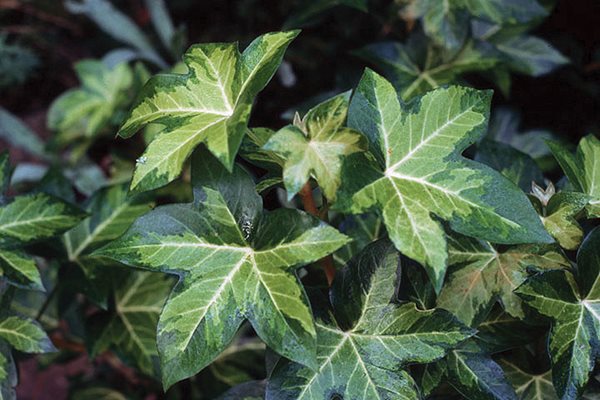
NEPAL IVY
One of the happiest times as a horticulturist or nursery person in North Carolina was the annual plant distribution engineered by the late J.C. Raulston, founding director of a unique plant collection and arboretum in Raleigh now called the JC Raulston Arboretum in his honor.
Each year in this salute to plants, a black trash bag full of rooted cuttings was handed out to members of the nursery trade at conventions across the state. For the arboretum the purpose was to broaden the selection of plants available for sale to keep the industry in high gear.
I was lucky to collect a wonderland of unique plants from those horticultural handouts. At the top of my list is the variegated Nepal ivy (Hedera nepalensis var. sinensis 'Marbled Dragon') I acquired in 1997. Today this treasure spills over the stone wall in my side garden. Its 5-inch lobed leaves have cream-colored veining and neat splatters of lime green. Mature plants can produce striking yellow or orange umbels of fruits. Plants are easy to propagate using only single-node cuttings.
The ivy’s hardiness has been listed as Zone 8 (usually in British references), but I’ve found it quite hardy in my Asheville garden (Zone 6b), where we often have windy winter nights around 0 degrees. While there is some leaf burn in really cold winters, the vines recover in spring.
One difficulty in writing about great plants is including a source. Fortunately I live near Sandy Mush Herb Nursery (www.sandymushherbs.com). Since the owners are longtime admirers of Raulston, I called proprietor Fairman Jayne and learned that the nursery does stock this plant and that it’s hardy at their location in the North Carolina mountains. “It's a beauty,” agreed Fairman,“ and a continuing salute to Raulston’s genius at collecting.”
—PETER LOEWER

PAWPAWS IN YOUR POCKET
In my earliest memories is a song with the lines “Pickin’ up pawpaws and puttin’ ’em in your pocket, way down yonder in the pawpaw patch.” But what is a pawpaw, and why would you want to put one in your pocket?
RELATED: Growing Fruit
The pawpaw (Asimina triloba) is a native tree, found in the eastern half of the United States, 20 to 30 feet tall, with large leaves, maroon flowers and delicious fruit similar in shape to a light green, stubby banana with a flavor like bananas and mangos. It is also an important host for the zebra swallowtail butterfly. I had known about this plant for many years since it is abundant on the shaded slopes of my hillside property, and I successfully moved several to my native-plant garden, despite the belief that it is difficult to transplant. But I had yet to sample the fruit. Some years ago I tasted an unripe pawpaw, which was not a good experience, and so began a quest to find a ripe one.
Early one September day in 2005, my luck changed. On a hike in a nearby park in Nashville, Tennessee, I noticed a gelatinous blob on the ground. Taking a closer look, I was overwhelmed by a fruity smell, then realized the trail cut through a grove of pawpaw trees. I scoured the canopy in hopes of finding more fruit, and there, dangling over my head, was a solitary pawpaw—but 15 feet or more up. I found a stick, took careful aim at the branch holding the fruit and flung it skyward, making a direct hit on the supporting branch and dislodging my prize. As it fell, I grabbed for it and caught it just before it hit the ground. Congratulating myself on an incredible catch, I carefully put the fragrant pawpaw into one of the large cargo pockets of my pants and continued my hike. As I got farther down the trail, I began to chuckle—I realized that I had picked up (or caught) a pawpaw and put it in my pocket.
At home I shared my delicious trophy with my family (except my wife, who has an aversion to weird fruit). My quest had come full circle from those early childhood memories of a song. My only regret is that I denied an opossum, squirrel or raccoon a particularly tasty treat that day.
—PAUL MOORE

WILSON LEMON
I’ll admit I’m not a huge fan of citrus as ornamental plants. Most can be big and gawky, some are wickedly thorny, and they must be schlepped in and out of winter storage here in New Jersey. Of course the scent of their blossoms sends me to olfactory nirvana, and I enjoy the fruit. Normally, they are large but not-so-showy players in the garden scene.
Not so the Citrus ichangensis (Wilson lemon). Small, barely thorny, and contained in an easily moved pot, it’s the one citrus to have if you have only one. Large numbers of scented flowers portend an abundant crop of medium-sized, bright-yellow fruit that causes the branches to arch.
RELATED: Trees
Given well-drained, moist soil, or potting mix in the garden, or in a roomy pot in full sun, a foot-high cutting will become a 3- to 4-foot specimen in a couple of years (up to 15 feet in time). You can grow it as a shrub or gradually remove the side branches and prune the top for a handsome topiary. Provide a balanced fertilizer during the growing season, and a shot of chelated iron if the foliage begins to yellow. Watch for mealybugs and scale insects. Outside of areas where it can grow outdoors year-round (Zone 8 and warmer), keep your plant happy during cold weather in a greenhouse, sun porch, conservatory, or very bright window. Enjoy it during frost-free weather outdoors as a specimen in a garden bed or on a patio. And every now and then squeeze one of those balloons into your favorite drink.
—Ray Rogers

Sharkskin Agave
During a trip to Puerto Escondido in Southern Mexico, I rediscovered the majestic agave plant, and ever since then they have occupied my conscious thoughts as well as sticking, or poking, into my dreams. At San Marcos Wholesale Growers in Santa Barbara, I recently found one I had never seen before: Agave ‘Sharkskin’. For me, this is a spectacular plant, either by itself as a striking accent or focal point, or planted en masse on a hillside. It provides strength and drama while enduring drought, as well as temperatures between 20 and 25 degrees. I love the way the shadows of the leaves fall across one another. And depending on the light, they may be a ghostly, silvery presence or alive as bold, slashing strokes.
The sharkskin is a robust, stout plant that is not susceptible to pests, will grow up to 3 feet tall, and is easy to maintain. Its muscular, shark-like appearance contrasts with the plum and maroon sheen of its leaf margins. General manager Randy Baldwin at San Marcos considers the plant a hybrid between A. victoriae-reginae and A. scabra.
Because of their self-sufficiency, agaves are often spread about a garden haphazardly. This does not do justice to their ability to make a dramatic statement when grouped together. And don’t underestimate the impact of their color. At Lotusland in Santa Barbara, Madame Ganna Walska used agaves in a blue garden as a primary visual statement, emphasizing their steel-blue tinge.
I admire the fact that while appearing humble, the agave is really a noble plant, enduring longer than others that initially seem more showy. The sharkskin agave is a wonderful exemplar of the genus—uncompromising, adaptable, ageless, a rare blend of subtle and stunning.
— Pamela Burton

Hayes Starburst
Most of us aren’t lucky enough to have even one special new plant pop up in our garden. It is even rarer when, this gem having fallen victim to moles, the same plant appears a second time. But that’s what happened with Hydrangea arborescens ‘Hayes Starburst’. Discovered by Hayes Jackson in his garden in Anniston, Alabama, this is one of the newest, most beautiful selections of our Southeastern native smooth hydrangea. The flowers first open as typical white lacecaps, but within days the outer florets double and form a starburst effect. Then the interior flowers also become double. Before the show is over, the entire inflorescence has become an ivory-green cream-frothing mass lasting several weeks. Compact in form, ‘Hayes Starburst’ will reach about 3 to 4 feet tall and wide. There have been some reports of it being temperamental, but I believe this to be a result of poor drainage—remember, the species grows hanging off cliffsides and on steep hills. Properly sited, mine has performed beautifully. Admittedly, it’s a little slower to develop than some of its siblings like ‘Annabelle’, but with a little patience and care, it will create a stunning specimen.
—Troy B. Marden

Thermopsis
I love the pea family, from the edible to the ornamental. Ever since I started bush beans in a milk carton in Miss Goodwin’s first-grade class, I’ve been hooked, and thermopsis is one of my favorites. I cut my teeth on the eastern native Thermopsis villosa, Carolina false lupine, which partially assuaged my longing for the summer lupines that look so lovely in European gardens. I’ve seen the dark-flowered T. barbata in Sichuan at 8,000 feet in the cool September mist, but there’s no way to mimic that here in Kentucky. But I’m very partial to another Chinese species that I’ve grown successfully for 10 years, T. chinensis. Even the buds are attractive, emerging grayish purple in mid-March, coinciding with the blooms of galanthus, species crocus and hamamelis. Then slowly they unfurl alongside blooms of hellebores, epimediums, Primula kisoana, Cardamine diphylla, Iberis sempervirens and Veronica umbrosa ‘Georgia Blue’. The frost-resistant soft-yellow spires of flowers above 20-inch stems and small grayish leaves will be fully open a week or two before redbuds and dogwoods, lending brightness and verticality to the perennial border. Miss Goodwin would be pleased.
— Allen Bush

ANGELICA GIGAS
I was introduced to Angelica gigas at a lecture by landscape designer Piet Oudolf. Years later, upon seeing his use of the plant in a border at Bury Court Garden in Surrey, England, my passion for this dramatic plant was ignited.
Korean angelica is a designer’s dream. A stunning architectural plant, it adds structure and depth while requiring minimal care. Its self-supporting stems, three to six feet tall, are topped by purpletinged petioles and luscious redpurple flowers, achored at the base by massive foliage.
Even with its size, it’s a great middle- to front-of-the-border “see through” plant due to the relatively leafless flowering stems. When planted in groups in larger settings, it’s an amazing focal point. A. gigas is awesome harmonized with Eupatorium maculatum ‘Gateway’, Euphorbia cotinifolia, Phlox paniculata ‘Eva Cullum’ and Miscanthus sinensis ‘Malepartus’.
Korean angelica is biennial, blooming in summer during the plant’s second year. The original plant will typically disappear after that, but don’t despair—it reseeds. Even if it needs to be replaced every few years, A. gigas is worth growing for its high impact and low maintenance. It will ignite your passion too!
—Tracy Disabato-Aust

JAPANESE SHRUB MINT
I am especially fond of Japanese plants. Having first been attracted by a sort of hydrangea-looking plant with variegated foliage, my attention was thus doubly engaged when I read the label: Leucosceptrum japonicum ‘Variegatum’. I had no idea what it was, other than a variegated plant native to Japan. “If you see something you like,” my mother used to say, “get it. Because when you come back, either it won’t be there or it will cost twice as much.”
Planted in woodsy, highly organic soil in dappled shade, this uncommon plant has become an elegant addition to my New Jersey garden. Called “celestial maiden” in Japan, its native haunts are the edges of deciduous woodlands in Hokkaido, Honshu and Shikoku. Growing to about 2 feet tall, it is a charming, clump-forming herbaceous plant with a woody base. In spring soft yellow variegation accents the medium green leaves, which become more chartreuse in summer. In October, bottlebrush spikes of flowers the color of old ivory decorate the top of each shoot. This spring I gave it a partner—Tricyrtis ‘Moonlight Treasure’, said to grow only 10 inches tall with buttery yellow flowers. I’m glad that, for once, I listened to my mother.
—JUDY GLATTSTEIN
Sources:
www.collectorsnursery.com/

Bell Reed
When I visit artist and gardener Marcia Donahue, she has my complete affection, but not my undivided attention. Uncommon even in her delightfully idiosyncratic Berkeley garden, Cannomois virgata, or bell reed, causes my mind to wander in its direction.
It commands attention, its architectural bundles of stalks growing eight feet tall plus, with cinnamon-colored sheaths and an abundant cascade of plume-like foliage resembling green ostrich feathers. Ideal as a tall textural accent, I prefer it as a focal point.
If you have well-draining, acidic soil, you should succeed with this restio from South Africa, where it takes cold snaps as low as 20 degrees. In areas lacking perfect conditions, containers are ideal — you can control the soil medium and easily winterize it in regions with snow. The container’s colors can even be used to highlight the cinnamon, salmon, light coral spectacle of the new stems.
If you’ve ever flirted with Mexican weeping bamboo,Otatea acuminata, or another restio from Africa, Elegia capensis, I urge you to start a love affair with Cannomois virgata.
— Dat Pham

Drimiopsis
It is an electric moment to be shaken from musing over the usual offerings at a local garden center by a plant I’ve never heard of before. It’s like hiking in familiar woods and having the compass needle go haywire. In this case, the plant tag combined the words “succulent,” “African” and “hosta” — I had to have it.
Though neither a succulent nor a hosta but a scilla relative from South Africa, Drimiopsis maculata has become one of the treasures of my little plant collection. Its subtle charm, quirky schedule and simple needs have endeared it to me over that past few years, tucked in a low pot by the front porch. Forming a clump about a foot wide and tall, the spoon-shaped, fleshy leaves are speckled with brown spots when new, changing to green in summer, and a little forest of 6- to 12-inch-tall, white-flowered spikes appear in late winter/early spring (one common name is little white soldiers).
Hardy to Zone 9, it’s a nice size for a container, so it can be grown as a houseplant or greenhouse plant farther north. It has proved quite durable in my Florida garden, helped by its natural winter dormancy, though I move it indoors if the weather gets close to freezing, just to be safe. Partial to light shade, it can tolerate a range of light situations, and laughs at heat, humidity and drought.
My first thought when I brought it home was “fussy collector’s plant, maybe it will be a good learning experience.” But it has proved itself a risk worth taking.
—Jenny Andrews




